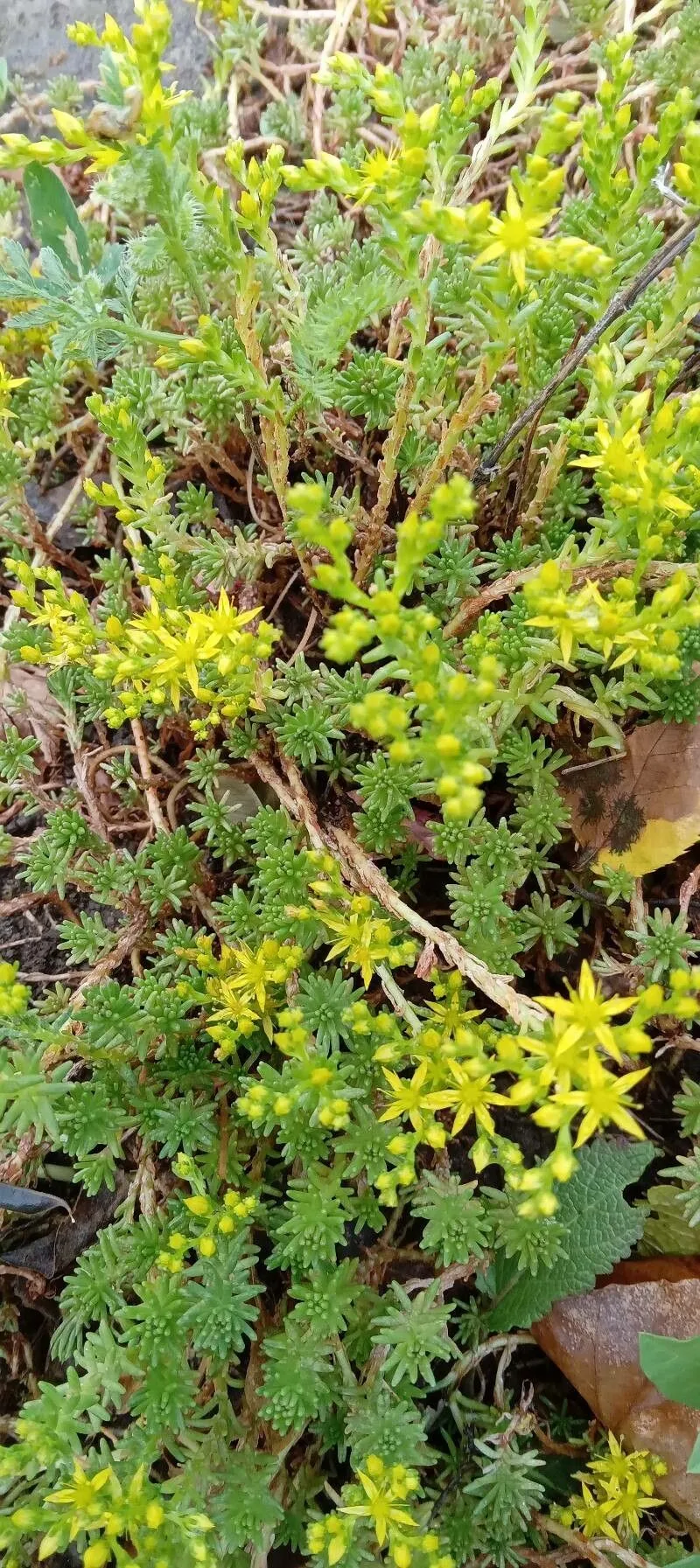
Author: L.
Bibliography: Sp. Pl.: 432 (1753)
Year: 1753
Status: accepted
Rank: species
Genus: Sedum
Vegetable: False
Observations: Europe
Tasteless stonecrop, known scientifically as Sedum sexangulare, is an intriguing and resilient member of the Crassulaceae family. This hardy, perennial succulent thrives primarily in Europe, showcasing the region’s diverse floral landscape.
First described in 1753 by the renowned botanist Carl Linnaeus in his seminal work “Species Plantarum,” this plant is well-documented for its distinctive characteristics and ecological adaptability. The herb’s Latin name, Sedum sexangulare, highlights its unique six-angled stems—a defining feature of this species.
Typically found in rocky, well-drained soils, tasteless stonecrop is adept at surviving harsh conditions, making it a popular choice for gardeners interested in xeriscaping or creating rock gardens. Its compact, mat-forming growth habit allows it to cover ground rapidly, providing an aesthetically pleasing, low-maintenance green carpet.
The foliage of Sedum sexangulare is dense and fleshy, with small, cylindrical leaves that are a vibrant green during the growing season. As the weather transitions towards summer, these leaves often take on a golden hue, enhancing the plant’s ornamental value. In late spring to early summer, the tasteless stonecrop produces clusters of small, star-shaped yellow flowers, adding a splash of color to its verdant backdrop.
Despite its common name, tasteless stonecrop is anything but ordinary. Its ability to thrive in nutrient-poor soils and withstand drought conditions makes it an essential species for preserving biodiversity in challenging environments. This plant’s role in preventing soil erosion and providing habitat for various insects further accentuates its ecological importance.
In summary, Sedum sexangulare, or tasteless stonecrop, is a robust and versatile succulent native to Europe. Celebrated for its adaptability and aesthetic appeal, it continues to be a valuable addition to both natural landscapes and cultivated gardens, illustrating the enduring impact of Linnaeus’s early botanical work.
Deu: milder mauerpfeffer, sechskantiger mauerpfeffer
Dan: sekradet stenurt, seksradet stenurt
Eng: tasteless stonecrop, hexagon stonecrop
Nob: kantbergknapp
Nno: kantbergknapp
Swe: kantig fetknopp, särmämaksaruoho
Lav: maigais laimiņš
Fra: orpin de bologne, orpin à six angles
Fin: särmämaksaruoho
Nld: zacht vetkruid
Cym: briweg ddi-flas, briweg diflas
En: Tasteless stonecrop, Hexagon stonecrop, Tasteless yellow Stonecrop
Be: Расходнік шасцірадковы
Hr: Žuti žednjak
Cs: Rozchodník šestiřadý
Da: Seksradet stenurt, Sekradet stenurt
Nl: Zacht vetkruid
Et: Kuuetine kukehari
Fi: Särmämaksaruoho
Fr: Orpin doux, Orpin de bologne, Orpin à six angles
De: Falscher Mauerpfeffer, Milde Fetthenne, Milder Mauerpfeffer, Sechskantiger Mauerpfeffer
Hu: Hatsoros varjúháj
Is: Svíahnoðri
It: Borracina insipida, Erba pignola
Lv: Maigais laimiņš
Nb: Kantbergknapp
Nn: Kantbergknapp
Pl: Rozchodnik sześciorzędowy
Sk: Rozchodník šesťradový
Sv: Kantig fetknopp, Särmämaksaruoho
Cy: Briweg Ddi-flas, Briweg Diflas
© copyright of the Board of Trustees of the Royal Botanic Gardens, Kew.
© copyright of the Board of Trustees of the Royal Botanic Gardens, Kew.
© copyright of the Board of Trustees of the Royal Botanic Gardens, Kew.
Taken Jun 30, 2021 by Timp Grätsch (cc-by-sa)
Taken Jul 1, 2021 by Burnand Sebastien (cc-by-sa)
Taken May 27, 2020 by Amanda Miranda (cc-by-sa)
Taken Nov 15, 2022 by Tarık Demir (cc-by-sa)
Taken Jan 14, 2018 by Dieter Wagner (cc-by-sa)
Taken Jun 3, 2022 by Fabrice Rubio (cc-by-sa)
Taken May 30, 2020 by jack (cc-by-sa)
Taken Jan 19, 2016 by EOL − Drepanostoma (cc-by-nc)
Taken Dec 25, 2020 by Lugifa Lugifa (cc-by-sa)
Taken Jan 14, 2018 by Dieter Wagner (cc-by-sa)
Taken Jun 3, 2022 by Fabrice Rubio (cc-by-sa)
Taken Jun 16, 2022 by Ernst Fürst (cc-by-sa)
Taken Dec 1, 2021 by Becher Maria Eduarda (cc-by-sa)
Taken Jul 31, 2016 by Pierre Bonnet (cc-by-nc)
Taken Jun 14, 2022 by Magdalena Šejvlová (cc-by-sa)
Taken Sep 11, 2022 by Quentin Faye (cc-by-sa)
Taken Feb 20, 2021 by Charlotte Limpens (cc-by-sa)
Taken Jun 19, 2019 by Emanuele Santarelli (cc-by-sa)
Taken Nov 6, 2022 by Fabio Regueira (cc-by-sa)
Taken May 22, 2018 by Lisa J (cc-by-sa)
Taken May 27, 2020 by Kira Duringson (cc-by-sa)
Taken Dec 28, 2020 by Suárez Guillermo (cc-by-sa)
Taken Jul 10, 2014 by Tela Botanica − Liliane Roubaudi (cc-by-sa)
Taken Jul 10, 2014 by Tela Botanica − Liliane Roubaudi (cc-by-sa)
Taken Jan 1, 1970 by Photoflora – L’Abbé COSTE (©)
Taken Jan 1, 1800 by Tela Botanica − Daniel MATHIEU (cc-by-sa)
Taken Jul 10, 2014 by Tela Botanica − Liliane Roubaudi (cc-by-sa)
Growth habit: Forb/herb
Light: 7
Bloom months: [‘jun’, ‘jul’]
Family: Myrtaceae Author: (F.Muell.) K.D.Hill & L.A.S.Johnson Bibliography: Telopea 6: 402 (1995) Year: 1995 Status:…
Family: Rubiaceae Author: Pierre ex A.Froehner Bibliography: Notizbl. Bot. Gart. Berlin-Dahlem 1: 237 (1897) Year:…
Family: Sapindaceae Author: Koidz. Bibliography: J. Coll. Sci. Imp. Univ. Tokyo 32(1): 38 (1911) Year:…
Family: Asteraceae Author: A.Gray Bibliography: Pacif. Railr. Rep.: 107 (1857) Year: 1857 Status: accepted Rank:…
Family: Fabaceae Author: Medik. Bibliography: Vorles. Churpfälz. Phys.-Ökon. Ges. 2: 398 (1787) Year: 1787 Status:…
Family: Aspleniaceae Author: (Cav.) Alston Bibliography: Bull. Misc. Inform. Kew 1932: 309 (1932) Year: 1932…